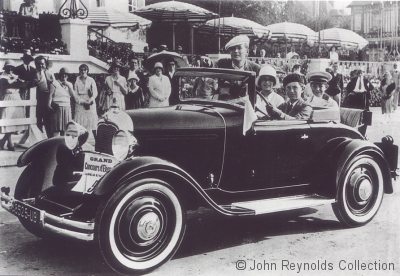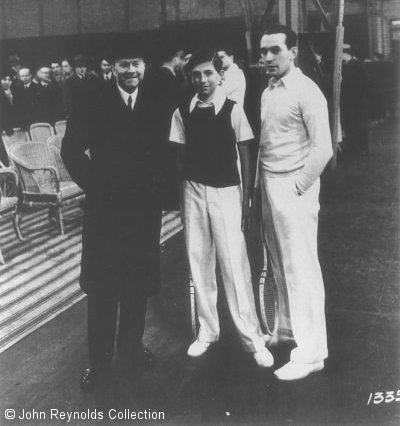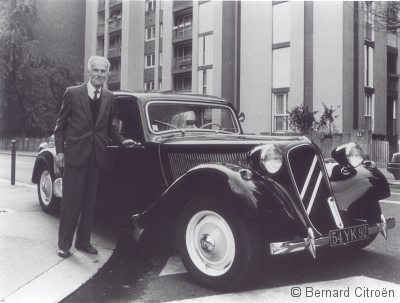|
|
|
 |
 |
|
|
|
This is the complete version of the obituary published in abbreviated form by the British newspaper the Daily Telegraph, on 13th August 2002
Bernard CitroŽn (1917-2002), by John Reynolds

Bernard CitroŽn photographed by John Reynolds in Paris in July 2000
Bernard CitroŽn, who died in Paris on August 9th aged 85 was the second child and eldest son of the French industrialist Andrť CitroŽn, the founder of Automobiles CitroŽn. During his boyhood years, as the heir-apparent to the motor car magnate often called the Henry Ford of France, he seemed destined to succeed to the throne of what was then Europe's largest automobile manufacturing empire. But in 1935, when he was only 18, the bankrupcy and death of his father (closely followed by the German invasion of France in 1940 ) caused his life to take a different turn and ultimately he won recognition not as a captain of French industry but as an officer in the Royal Air Force, piloting tactical bombers during the Liberation of Europe. Later, he went on to achieve distinction in the world of belles lettres, as a writer and poet and member of the celebrated French literary society, the Academie du Var.
His father, Andrť CitroŽn, an engineer-entrepreneur of Dutch-Jewish origins, was the first industrialist in Europe to begin the mass-production and mass-marketing of automobiles in the American manner, founding his Double Chevron marque in 1919 at an assembly plant located at the Quai de Javel on the left bank of the Seine in Paris, in the huge munitions factory that he had built during WW1. Within ten years, its output had overtaken that of all the older-established French car makes such as Renault and Peugeot combined, to make Automobiles CitroŽn the fourth biggest car concern in the world and the largest outside the USA. In 1929 it turned out more than 100,000 vehicles, a total that was not seen again in Europe until the 1950s.
This remarkable success made Andrť CitroŽn an immensely wealthy man, well able to afford the lavish bon vivant life-style that made him the target of gossip-columnists in England as well as France. His vast profits enabled him to fund his love of gambling at racecourses and casinos, to indulge to the full his weakness for advertising and publicity and, above all, to lavish boundless generosity upon his three children, Jacqueline, Bernard and Maxime, on whom he doted. Thus, Bernard and his siblings enjoyed an eventful upbringing, even by the hedonistic standards prevailing in Paris during the Roaring Twenties. Throughout that era, images of the CitroŽn family at play were published constantly by newspapers, magazines and newsreeels placing them among the modern world's first media celebrities.
For example, in July 1925 Bernard and his brother and sister accompanied their father to the ceremony inaugurating the illuminations that Andrť CitroŽn had installed on the Eiffel Tower to celebrate the opening of the international Exposition des Arts Decoratifs et Industriels, the birthplace of the Art Deco movement. Thereafter, every night for the next ten years, Bernard could observe his family name flashing in the sky over Paris, spelled-out in huge letters 100 foot high by 250,000 electric light-bulbs fixed to the sides of the Eiffel Tower, forming a gigantic advertisement visible sixty miles away. |
Bernard CitroŽn was also present when, two years later, on 27th May 1927, his father threw a huge party at the Quai de Javel factory to welcome Charles Lindbergh who had landed in Paris three days previously, having made the first solo flight across the Atlantic. In the course of these ceremonies, he was called upon to present a gift of jewellery to the American aviator.
Regularly throughout that period the CitroŽn family took their winter holidays at Saint-Moritz in the company of Charlie Chaplin, while in summer they they always rented the same seaside villa at Deauville where they entertained their friends from Paris; typically the guest-list included such celebrities as Coco Chanel, Josephine Baker and Maurice Chevalier.

Bernard CitroŽn with his father, mother, sister and brother on holiday with Charlie Chaplin at St Moritz, January 1932.
L to R: Bernard CitroŽn, Maxime CitroŽn, Charlie Chaplin, Mme CitroŽn, Andrť CitroŽn, Jacqueline CitroŽn
To amuse his children, Andrť CitroŽn presented them with an electrically-powered half-scale model of the latest CitroŽn model which, with the permission of the Deauville police, they were allowed to drive about the town on the public roads. Every season, they would enter their little car in the annual Concours d'Elegance held by the Deauville automobile club.
But, sadly, the good times did not endure. In 1934, with typical over-optimism Andrť CitroŽn decided to reconstruct his factory in order to launch a revolutionary new car, the Traction Avant, the world's first mass-produced front-wheel-drive saloon. Alas, he had misjudged the economic situation for by then the Depression had arrived in France. The result was that his firm ran headlong into a severe financial crisis, made worse by the plunging sales of his existing range. A creditor's moratorium was established, but when this was broken by an impatient minor creditor, Automobiles CitroŽn was adjudged insolvent and taken-over by its largest creditor, the Michelin tyre company, to which Andrť CitroŽn had already pledged his personal shareholding.
Having lost his firm, his fortune and even the rights to his name, the following year he died of cancer in a Paris clinic.
Bernard Maxime CitroŽn was born in Paris on 4th June 1917. Educated at the Lycťe Saint-Louis on the Left Bank, in 1936 he followed in his father's footsteps by entering the Ecole Polytechnique, the technical academy of the French military and civil services, passing out in 1939. In May 1940, at the height of the drole de guerre or phoney war he was called-up for compulsory military service and began training as a pilot at the Armťe de l'Air flying school located at Versailles. When the invading German army arrived in Paris the following month, however, his unit was hastily transferred to Royan and then on to Toulouse.

Bernard CitroŽn (at the wheel) with his brother and sister and Maurice Chevalier, in their C4 Cabriolet at Deauville, September 1930
In August 1940, following the fall of France and the signing of an armistice with Germany, the country was divided into two separate zones, occupied and unoccupied, the northern part falling under German military control while the southern part was administered by a collaborationist French government led by Marťchal Pťtain, based at Vichy.
As a result, in common with the majority of French servicemen, the young Lieutenant CitroŽn was immediately demobilised. The following January, he enrolled in the Ecole Superieure du Pťtrole, a faculty of the University of Strasbourg based at Clermont-Ferrand, and after gaining his diploma he began his career as an engineer in the petro-chemical industry, by joining the French state-owned Aquitaine Petrol Company, engaged in exploring for oil and gas in the south west region of France.
Almost from the very outset of the Occupation, the German military authorities and the civilian Vichy regime both began to introduce a systematic campaign of intimidation and persecution upon the country's extensive Jewish population, intended to eliminate Jews from all positions of power and influence in French national life. Indeed, in the Occupied Zone of France, these anti-semitic measures, imposed by martial law and enforced by the Gestapo, were even harsher than those existing in Germany.
Although the CitroŽn family were no longer active practicing members of the Jewish faith, they, too, were subjected to this persecution and before long many of their closest friends and relations began to disappear, rounded up by the Gestapo and despatched on the journey that led inevitably to the concentration camps of the Third Reich. The most notable of these victims among the CitroŽn family was Bernard CitroŽn's first cousin Louis-Hugues CitroŽn (Andrť CitroŽn's nephew). A leader of the Resistance in the Marseilles region, he was captured at NÓmes in November 1943 and deported to Auschwitz-Birkenau, where he was executed in the gas chambers the following March.
Observing the realities of Hitler's New European Order at first hand, in December 1942, now aged 25, Bernard CitroŽn decided to attempt his escape from France, by making his way to England and joining the many other former French servicemen rallying under the command of General de Gaulle. After crossing the Pyrenees on foot during the height of winter he reached the British Consulate in Barcelona the following April, and on enlisting in the Free French Air Force he was smuggled along the clandestine route that led across Spain and Portugal.

Bernard CitroŽn (aged 15) with his father, Andrť CitroŽn and the French tennis champion, Henri Cochet
After many adventures including a spell in prison, twenty weeks later he reached Lisbon and was flown to Bristol on board a Dakota aircraft, arriving in London early in June 1943. Here at an address in Duke Street he met his maternal uncle, Jacques Bingen, who had already fled from France in 1940, to become a leading member of the exiled French Committee for National Liberation.
Nine months later, after passing through elementary flying school at Wolverhampton and an advanced pilots course at RAF Cranwell he gained his wings as a Flying Officer in the RAF.
In April 1944 he was posted to an Operational Training Unit at Finmere, before joining No 342 Squadron ( staffed entirely by French air crews and known as the Lorraine Squadron ) a unit equipped with twin-engined Douglas A-20 Boston tactical bombers, based at Hartford Bridge near Camberley.
As part of the Second Allied Tactical Air Force, throughout July and August 1944 Bernard CitroŽn's squadron was assigned to support the ground forces engaged in the liberation of France, following the Allied landings in Normandy which had commenced on D-Day, the 6th June.
Bernard CitroŽn in the cockpit of the Douglas A20 bomber which he piloted during the liberation of Europe in 1944 and 1945, while serving in the No 342 (Lorraine) Squadron, RAF . Almost a month after the recapture of Paris on the 25th of August 1944, Bernard CitroŽn reached the capital himself, arriving at le Bourget aerodrome on the 20th September after piloting a party of French officers from London in an Oxford liaison aircraft. Immediately upon landing on French soil once again, he made straight for a rendez-vous with his family who had spent the occupation lying low at their apartment in the centre of Paris, rarely leaving the premises by day, in order to avoid the attentions of the Nazis. Nights were never passed at home, however, as it was always very early in the morning that the police would come to arrest those who were to be deported.
On being reunited with his mother for the first time in almost three years he was appalled to learn that his uncle Jacques Bingen ( whom he had last seen in London less than eighteen months previously ) had been captured by the Gestapo near Clermont-Ferrand only four months beforehand, during the early part of May 1944. Following the execution of the Resistance leader Jean Moulin at the hands of the notorious SS chief Klaus Barbie, the Butcher of Lyon, in July 1943, Jacques Bingen had been parachuted into France to replace him, tasked with the mission of directing and coordinating sabotage activities behind German lines, to prevent Wehrmacht reinforcements and supplies reaching Normandy. Unfortunately, he had also fallen into enemy hands. To avoid betraying his comrades under torture, he had chosen to take his own life by swallowing a cyanide capsule.
After spending the remainder of the war with No 342 Squadron, based initially in Normandy and then later in Holland, Bernard CitroŽn was demobilised from the RAF in October 1945, having reached the rank of Squadron Leader. Between June 1944 and May 1945 he had flown more than seventy five missions over France and Germany, service for which he was awarded the Croix de Guerre with five bars and, ultimately, the distinction of Commander of the Lťgion d'Honneur, military class.
In January 1946, he found himself once more in Spain, having been sent to Madrid by the French government, to head an allied mission formed to locate and recover German assets. Finding the Spanish way of life agreeable, and having joined the Roman Catholic faith, when this work ended two years later he decided to stay on the Spanish capital, employed by a small agency involved in the importation of various makes of French automobiles. In due course, he opened an import agency representing, amongst other French industrial and engineering firms, the gear wheel manufacturing company that his father had opened in 1902, the Sociťtť Engrenages CitroŽn. His stay in Madrid lasted until 1958, when he returned to Paris and rejoined the French petrol-chemical industry, taking-up employment with Hydrocarbures des Pyrenťes, a subsidiary of the Elf-Aquitaine / Total oil conglomerate, engaged in mineralogical exploration and development work overseas. Over the next twenty-five years, until his retirement in 1982, his activities as an oil company executive regularly took him abroad, to Argentina, Iran, India and, ultimately, Mexico.
During his retirement Bernard CitroŽn was able to concentrate on the subjects that had always been his principle interests in life, literature and tennis; for his achievements as a poet he had earlier been elected, in 1979, a member of the distinguished French literary society, the Academie du Var.
In the latter years of his life, however, he became increasingly involved in an attempt to unravel the opaque and complex financial and political affairs surrounding his father's demise. As a result of his extensive researches, he formed the view that the unfortunate affair had been no commercial accident, but that the CitroŽn family had actually been the victims of a devious plot to swindle them out of the rightful ownership of their company.
In his autobiography published in 1996, entitled le Conjuration de Javel ( the Javel Conspiracy ) he set out the arguments supporting his controversial case. But to his great disappointment the book failed to make an impact in France, least of all among the many millions of motorists who continue to buy CitroŽn cars today, unaware of the tragic story of the founder of the Double Chevron firm. Automobiles CitroŽn is currently managed by its third owners, Peugeot SA, having been sold by the Michelin family in 1975.

Bernard CitroŽn with CitroŽn Traction Avant in 1997. Photographer unknown
In his autobiography Bernard CitroŽn also described how in the summer of 1934 he had been driven with his father from Paris to Deauville in a prototype example of the V8 engined 22CV version of the Traction Avant, exhibited at the 1934 Paris Salon but never commercialised. At the wheel was Dennis Kendal, the Anglo-American engineer who represented the suppliers of the body presses and tooling that Andrť CitroŽn had ordered from the USA to construct the Traction Avant, the Budd Manufacturing Company of Philadelphia. Some ten years later, while stationed at RAF Cranwell, CitroŽn met Kendal again. By this time Kendal had become the Member of Parliament for the nearby Lincolnshire town of Grantham where he was also Managing Director of a factory that manufactured Hispano-Suiza cannons for the RAF's Spitfire and Hurricane fighter aircraft.
Bernard CitroŽn married, in 1952, Piroska Szabo, a Hungarian by birth, who died in 1996. He is survived by his three sons, Henri-Jacques, Philippe and Bernard-Louis.
© 2002 John Reynolds
John Reynolds is the author of many books about CitroŽn including the widely acclaimed "From A to X - 75 years of CitroŽn in the UK" which is due to be republished in expanded form soon.
Julian Marsh and CitroŽnŽt would like to extend sincere condolences to the CitroŽn family on the occasion of their loss.
© 2002 Julian Marsh/CitroŽnŽtCitroŽnAmi would like to add to express condolences to the CitroŽn family on that terrible event.
Download File